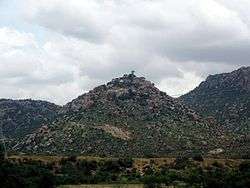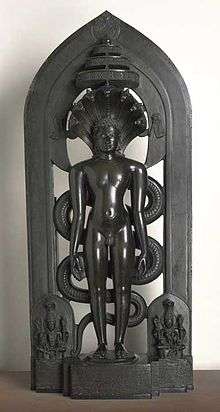Penukonda
Penukonda is a town in the Anantapur district of Andhra Pradesh, India. It is 70 km away from Anantapur (Officially: Anantapuramu) town.[1]
Penukonda | |
|---|---|
 Chilla Pahad near Penukonda | |
.svg.png) Penukonda Location in Andhra Pradesh, India | |
| Coordinates: 14.085°N 77.596°E | |
| Country | |
| State | Andhra Pradesh |
| District | Anantapur |
| Government | |
| • Type | Panchayati raj |
| • Body | Gram Panchayat |
| Area | |
| • Total | 6.5 km2 (2.5 sq mi) |
| Elevation | 769 m (2,523 ft) |
| Population (2011) | |
| • Total | 27,382 |
| • Density | 4,200/km2 (11,000/sq mi) |
| Demonym(s) | penukondavi |
| Languages | |
| • Official | Telugu |
| Time zone | UTC+5:30 (IST) |
| Vehicle registration | AP 02 |
| Nearest city | Hindupur |
| Vidhan Sabha constituency | Penukonda |
Demography
According to The Imperial Gazetteer of India,[2] Penukonda was a subdivision and taluk of Anantapur district in Madras province. It contains 96 villages covering an area of 677 square miles. The population in 1901 was 92,482 compared with 81,104 in 1891. Penukonda was the headquarters with a population of 6,806. The Penner River flows along its western and Chitravati river along its eastern boundary.
History
This region was controlled at different points in history by the Hoysalas, Chalukyas, Vijayanagar, Nawabs, Maratha chieftain Murari Rao, Tipu Sultan, Nizam and eventually came under British rule after it was ceded to the British by the Nizam of Hyderabad.[3] It was a melting pot of different religions but the town and fort were established by early Hoysala kings, who were practitioners of Jainism.

After Krishna Deva Raya, Venkatapathi Rayalu, the Emperor of Vijayanagar, took over. He made Raya Dalavayi Koneti Naidu (son of Kasturi Naidu, grandson of Akkappa Naidu, great-grandson of Kanaka Naidu of Chandragiri), as the governor of Penukonda and conferred him the title with Maha-Raja-Raja-Sri and celebrated Koneti Naidu's marriage with Swarna. Koneti Naidu ruled Penukonda, Rayadurga and Kundurpi Forts for about 17 years (1635-1652 AD). After the ruling of Koneti Nayudu his descendants Raya Dalavayi Sri Venkatapathi Nayudu, Peda Timmappa Nayudu, Venkatapathi Nayudu, Koneti Nayudu, Rajagopala Nayudu and Timmappa Nayudu ruled this Penukonda.
Because of its ancient Jain history and presence of many temples it is one of the most revered places for Jains. In the Tamil Jain tradition, this is counted as one of the four Jain centers of learning (Vidystahana) i.e. a Bhattaraka matha which are Delhi, Kolhapur, Jina Kanchi and Penukonda.[4] The famous Pache Parsvanath Swamy Temple, with idol of Parsvanath containing a single green coloured stone (Pacha) is located here.[5][6] According to the inscription on the image, it was consecrated in A.D. 1359, by a disciple of Mula Sangh Nandisangha's Balatkara Gana, Saraswathi Gachha, Kondakundanvaya's Priyarajaguru Mandalacharya Maghanandi Siddantha Deva. It was once the seat of a Jain Bhattaraka, established in A.D. 1359. The seat became extinct and the local Jain population declined. However the temple is well preserved. Also located her is the historic Ajitnath temple from the same period. After renovation by the Gowdanakunte family of Amarapura, it was preserved by Muni 108 Sri Ajithakeerthi Maharaj. After his samdhi in 1966, the temple was in poor condition byt has recently been renovated by the Dharmasthala institution.[7]
Kumbakarna garden here spreading over 5 acres has a Gigantic statue of the sleeping Kumbhakarna, measuring 142 feet in length and 32 feet in height into whose cavernos belly one can walk. Several asuras are seen trying to wake up the sleeping Gaint, depicting the famous story of this in invincible brother of Ravana in Ramayana.[8]
Assembly constituency
Penukonda is an assembly constituency in Andhra Pradesh.
Notable names in history – The Penukonda family name was responsible for developing the popular Kadapa stone that is used for granite countertops.
- 1952 – L.N. Reddy (Independent)
- 1955 – Chidambara Reddy (Indian National Congress)
- 1962 – Narasireddy (Independent)
- 1967 – Narayana Reddy (Indian National Congress)
- 1972 – S.D. Narayana Reddy (Indian National Congress)
- 1978 – G. Narayana Reddy (Indian National Congress I)
- 1983 – S. Ramachandra Reddy (Telugu Desam Party)
- 1985 – S. Ramachandra Reddy(Telugu Desam Party)
- 1989 – S. Chennareddy (Indian National Congress)
- 1991 – S.V. Ramana Reddy (Indian National Congress)
- 1994 – Paritala Ravindra (Telugu Desam Party)
- 1999 – Paritala Ravindra (Telugu Desam Party)
- 2004 – Paritala Ravindra (Telugu Desam Party)
- 2005 – Paritala Sunitha (Telugu Desam Party)
- 2009 –B K Parthasarathi (Telugu Desam Party)
- 2014 – B K Parthasarathi (Telugu Desam Party)
- 2019 - Malagundla Sankaranarayana (YSR Congress Party)
References
- "Anantapur District Mandals" (PDF). Census of India. p. 421. Retrieved 6 June 2017.
- Penukonda in The Imperial Gazetteer of India vol 20, pp: 104-5.
- http://www.anantapur.com/travel/penu.html
- Jain Monuments of Andhra, G. Jawaharlal, Sharada Publishing Houe, 2002, p. 74
- A speed-breaker called Penukonda, The Hindu, Jul 10, 2004
- Penukonda
- "Sri Ajithanatha Digambar Jain Temple Penkonda, 2019". Archived from the original on 21 August 2018. Retrieved 22 March 2019.
- "Archived copy". Archived from the original on 5 March 2017. Retrieved 13 June 2016.CS1 maint: archived copy as title (link)